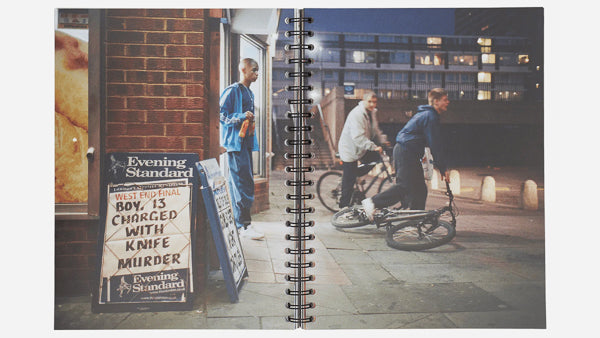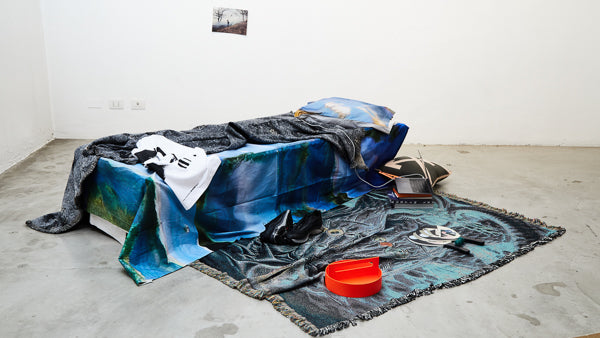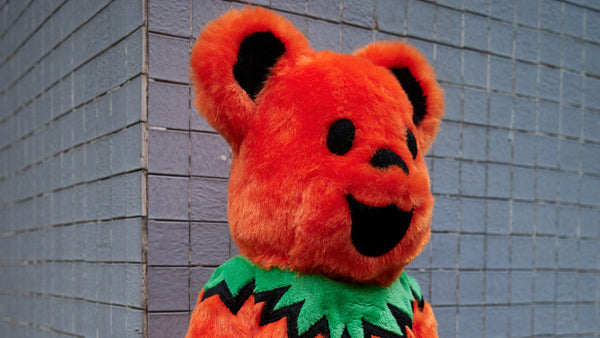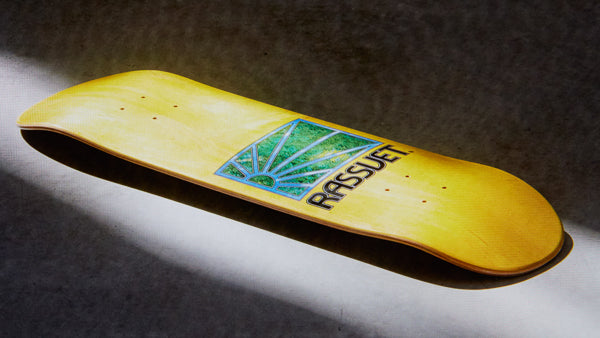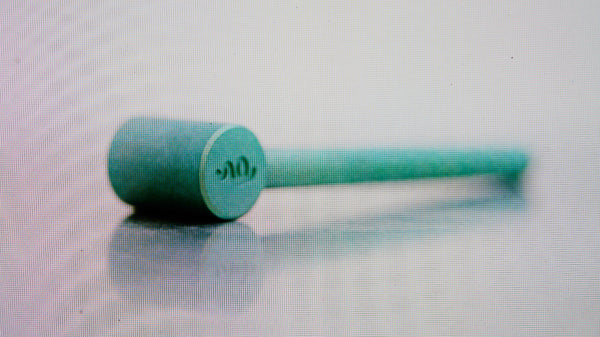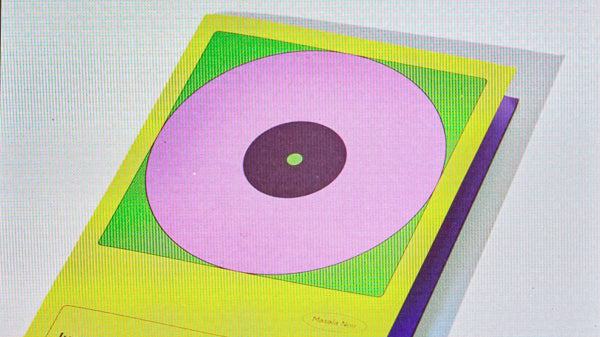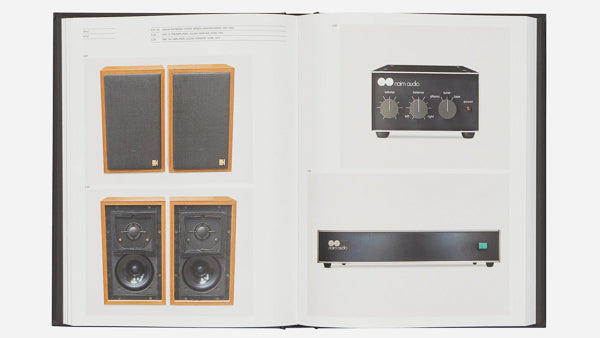CULTURE 10.05.18
CULTURAL AGITATORS W/ ACW* SAMUEL ROSS
Words by Arthur Bray
Photos by Stanley Cheung
Video by Isus Williams
Distressed, worn-in council estate blocks are a familiar sight for those who live in the metropolis city. Such infrastructures were once grand achievements built to supply uncrowded homes on secure tenancies at an affordable rent to the working class. In cities like London, many of these developments did not live up to the hopes of their supporters, and in turn, suffered urban decay. To many, these towers loom in the background as a reminder of society’s underprivileged, but to fashion designer Samuel Ross, they provide key inspiration to his label, A-COLD-WALL*.
The designer was recently shortlisted for the LVMH Prize 2018, news which shortly arrived after a successful series of ventures with brands like Nike and Oakley.Samuel is on a roll and he ensures that his schedule is filled with little breaks, a tip which he learnt on the job as Virgil Abloh’s former creative assistant. “Virgil’s a mentor, I really learnt the pace you have to work to get somewhere. To put in insane numbers of hours and to always be constant,” said Samuel. Whether it’s an installation or a capsule collection drop, each project complements the next and is a real time documentation of the designer’s thought process. To Samuel, it’s imperative that his work carries a perspective, and that “good design isn’t just about selling products. It’s about social commentary.”
Enjoy the first part of our Cultural Agitators series as we explore the minds of streetwear and fashion’s most revered designers. Here’s Samuel speaks on the meaning behind A-COLD-WALL*, Brexit and much more.
SJSJ: A-COLD-WALL* is a theme based on a geographic landscape; but as the brand has expanded, how have you been able to correlate your designs with the theme?
SR: The brand has an overarching theme in working-class Britain. We look at various funnels that stem from this subject. For example, it could be actual characters in the working class. Who are these personalities? How are they combatting the circumstances? Or perhaps, a dilapidated building, and studying what information I can pull from it. Then, I think of how to interpret these sensibilities into design through a selection of materials. We build a sub-story from a primary story. It’s almost like we’re applying a treatment to individual narratives, or a lens, if you will. I work around a few key words, and from there I pair ideas and the aesthetics I’ll deliver with the use of textures and fabrics to create fashion. The keywords are the guidelines.
SJ: These keywords, are they words that are based off feelings or products?
SR: I think it’s both, my goal is to turn these feelings into products and clothes. A graphic on a T-shirt could be extracted from a perception I have on what a worn-out tower block might signify. Sometimes, it’s tricky to make sentences of ideas because the props or tools used in my installations – such as an industrial fan, a plastic tarpaulin sheet used to separate rooms, or tin foil that wraps the exterior of a store – are tangible representations of the thought-process of my ideas. Taking these ideas and turning them into experiences is how I create products from feelings.
SJ: Tell us about where you’re from and how this has informed A-COLD-WALL*?
SR: I was born in South West London, but I moved when I was three years old to a rural part called Wellingborough where I went to school, after which I then came back to Brixton. Coming back to London after school in Wellingborough made me realize the mentality of a certain sector of people who were given a different type of education. For example, the college in my town taught Design and Technology and basic craftsmanship, but performing arts, psychology and sociology weren’t options. Areas like this would later have the second highest vote in Britain for Brexit. A lot of A-COLD-WALL* is based on the scepticism of growing up in Brexit areas and places that are marginalized. I came back to Brixton when I was a lot older. It had changed a lot with gentrification.
SJ: With gentrification, the once mythical tower blocks to council estates have become popular backdrops to lookbooks. Do you consider this very tumblr friendly?
SR: The use of tower blocks in this way has always pissed me off. I would never shoot with the tower block as the backdrop, because it has become too cliché. I want to pick out the nuances and echos of what these towers represent rather than just using them as props.
SJ: By referencing the working-class estates as a core subject, do you intend to give back to the community in which you were raised?
SR: I think it’s about making sure this narrative is told. I don’t think it’s been told properly in a form that’s more avant garde or intellectual. Many stories are being told about British subculture, from punk, reggae and skinheads, to mods and rockers. I want to use A-COLD-WALL* to tell my interpretation of British culture. Whether this is in a direct way or in some sort of secondary message, it doesn’t have to be so literal. I want to create an umbrella subject in which I can talk about a number of issues that stem from it.
This could be some of the social and political circumstances someone living in a council estate faces, or statements I’ve made in “Academia* CORRECTION WORK SHOP,” a weekend-long pop-up store in London where I recreated a classroom setting. For this project, I created graphics with a right-angled triangle on the title of the installation with “WORK SHOP” struck through. We’re taught in school that asterisks are used to denote or annotate, while a strike is a sign of disapproval or critique in revision associated with writing workshops. I’ve rehashed the mediums we’re taught in school to question the systems on which we were raised.
SJ: How would you like the audience to interpret these installations?
SR: I’m making a narrative that people can pick at if they want, or can just take at face value. It also gives me a direction to work with when planning, making my collection coherent throughout. For each release to have substance, it’s very important to have a surface level design from a brand perspective that matches a deeper meaning that’s justifiable.
SJ: It goes without saying that you like putting installations together?
SR: Ha, I can’t just give someone a T-shirt – I would feel like I’m selling someone short. It needs to be a whole experience that ties back into the theme. I recently did a pop up in LA’s H. Lorenzo on an exclusive drop that was paired with the ‘COMPRESSION’ structure. The installation was themed around the sustained reaction between underclass utilitarianism interpreted through the lens of the upper class, and the inability of the working class to make progress when faced with repeated barriers. Yet, given the circumstances, this social group is able to discover despite adversity.
SJ: How were you able to deliver this sensibility in the installation?
SR: This push-and-pull feeling was conceived through pop-up where the store was split by strip curtains suspended from the ceiling. Entering a different arena, the audience was introduced to a dense tunnel made up of fifty 10’ x 10’ sheets of Mylar plastic suspended by 200 steel wires creating a frame. Entering the tunnel, participants push through the plastic and navigate forward before discovering the clothing rail at mid-point just as they’re caved in by plastic. This claustrophobic, suppressed feeling is what I’m trying to deliver with ‘COMPRESSION.
SJ: Has each project been accompanied by a physical experience?
SR: In-store experiences, yes. E-commerce, harder as that follows a complete different rhythm but you can still use packaging to convey a theme. For those who weren’t able to attend the ‘ACADEMIA* CORRECTION WORKSHOP,’ the experience could still be shared via a notepad or branded pencil if you ordered online. These products carry the nuances of particular projects or collections.
'“a lot of a-cold-wall* is based on the scepticism of growing up in brexit areas and places that are marginalized.”
SJ: Prior to the launch of A-COLD-WALL*, you worked in advertising. What are the parallels between both worlds?
SR: Advertising’s key is to sell, but the process of getting the customer to invest in a project can also be motivating. I love producing content, and it’s interesting to be able to articulate a theory in more than just one medium. When it comes to selling, I’m fortunate enough with A-COLD-WALL* where I can focus on the work, to showcase a feeling rather than creating something commercial. Between advertising and design, I’ve found an interesting way to interact in both worlds in a streamlined way, to create a relationship with a product. But overall, with fashion you can take risks, but you can’t with advertising.
SJ: Can’t you take risks in advertising?
SR: In fashion, I can interact with an audience with a conceptual theory and there’s more room for interpretation. But with advertising, I have to create work that’s reliable, and can cause a specific reaction to fit the brief. Like advertising for H&M or a big fashion house, there’s so many overheads they have to cover. The overall message is important and I have to be careful with what I’m trying to say. A-COLD-WALL* is completely independent and promotes the idea of resulting creativity, so it gives me fluidity in terms of marketing and advertising.
SJ: How was it working with Virgil Abloh? What did you learn through your tenure at OFF-WHITE?
SR: Virgil is a mentor. I really learnt the pace you have to work to get somewhere. To put in insane numbers of hours and to always be constant. That’s what a lot of people don’t understand. You really have to sacrifice everything to get a project or business off the ground. Also, never really being satisfied with your work. Almost having a blind confidence that I’ve learn what it takes.
SJ: Following your stints in advertising and with OFF-WHITE, what gave you the confidence to launch A-COLD-WALL*?
SR: I’ve made this habit of listing every design effort I’ve been involved in since 2011 on my personal website. As I moved forward in my career, I had everything documented so it served as a self justification and to others that I can launch a brand. This is a bulletproof A to Z list of how I can articulate in such a way. It’s a reminder and a tangible list. Kind of like markings on a tree.
SJ: How have you been commenting on Brexit and Britain’s political climate?
SR: No one has really figured this out, but the reason why there’s a 17 at the back of the SS/18 hoodie is based on the leaver hoodies you get when your graduating university. I put 17 on a lot of the apparel that are isolated from other graphics because that’s when Britain decided to leave the European Union. union. So there are subtleties littered throughout. I want to present local messages on global platforms. There was a Theresa May and Jesus montage hoodie I was going to print in the latest runway show but I thought it was a bit too sensitive. It was literally an amalgamation of the two’s identities, which speaks on the miscommunication of religion and the state and how we’re dealing with Generation X. I’m touching on a range of issues that might not be obvious because it isn’t in the forefront but it is still very much spoken about. You need to speak about what’s going or care. Because if you don’t care about communication then there’s no point of doing what you do as a designer. Whether that’s fashion or industrial design, there should always be a point about what you’re making. It’s not about just doing cool shit for me, it’s about presenting a statement.
SJ: You’ve worked twice with Nike on the Air Force One. How have you been able to carry out your ideas on the iconic model?
SR: The AF1 is such a great shoe. The first time I worked on it was in June 2017 for fashion week, via a more distressed and worn-in perspective. The second time was a more more retail-friendly, ready-to-wear AF1 high which is really about celebrating invisible information. They both carry the same message but are presented in different ways. Ready- to-wear takes the energy off runway and puts it in wearable context and in softer form, whereas runway exists for artistic purists which makes people fall in love with the ready-to-wear too.
SJ: You’ve also launched a sub label called RE-ALIGNED*, how does this continue to A-COLD-WALL* aesthetic?
SR: It goes back to my background rooted in product and graphic design. Working in both those industries for five years and professionally for approximately two to three years. Then applying this perspective on how materials are used. When I say material I mean fabrics. The reality is my fabric is not the same as a seamstress because my background is graphic design. So I look at how I can manipulate and warp these materials. This comes from the same thinking as how I can get a wall and break it down before throwing paint all over it, that’s obscenity to a dressmaker, but to me, that’s how I lift a fabric to make it into something else. Similar material but used differently. With less respect for sure.























